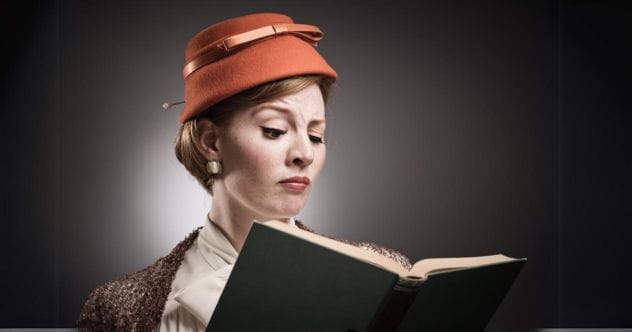Ernest Hemingway once said that when writing a novel, a writer should create living people, not caricatures. Good characterization invites the reader to personally identify with a narrative. What makes believable fictional people? Many writers are inspired by real individuals. Classic fiction is filled with memorable characters that owe their depth to being based on real people.
10. Anonymous Lunatic/Bertha Mason-Rochester
Charlotte Brontë’s Jane Eyre (1847) tells the story of Jane, an orphan who becomes a governess at Thornfield Hall. She falls for Edward Rochester, her employer. However, on their wedding day, Jane discovers that Rochester is already married to Bertha Mason, a mixed-race woman locked away in the attic due to her insanity.
Brontë drew inspiration for Bertha from a visit to Norton Conyers manor house in North Yorkshire in 1839. She heard tales of a madwoman imprisoned in a remote attic room. The manor itself served as the model for Thornfield Hall. Bertha may also have been inspired by Eliza Raine, who was taken to an asylum after her lover’s infidelity.
9. William Henley/Long John Silver
Robert Louis Stevenson’s Treasure Island (1883) features Long John Silver, a complex pirate with a missing leg. He is both attractive and repellent, brutal and sympathetic.
Stevenson based Long John Silver on his friend, the poet William Ernest Henley. Henley had his left leg amputated due to tuberculosis. Stevenson confessed that Henley’s “maimed strength and masterfulness” inspired the character.
8. Welsh Brunty/Heathcliff
Emily Brontë’s Wuthering Heights (1847) centers on Heathcliff, a dark, brooding character. He is a foundling adopted by the Earnshaw family who seeks revenge against those he feels have ruined his life.
Heathcliff’s real-life parallel is Emily Brontë’s great-grandfather, Welsh Brunty. Welsh was an orphan adopted by Hugh Brunty. Like Heathcliff, Welsh was expelled from the house after Hugh’s death. He later became prosperous but turned cruel and abusive.
7. Thomas Lefroy/Mr. Darcy
Jane Austen’s Pride and Prejudice (1813) features Mr. Darcy, a wealthy, proud man who falls in love with Elizabeth Bennet. Initially, Elizabeth is put off by Darcy’s arrogance, but she eventually sees his humility and accepts his proposal.
Mr. Darcy’s real-life counterpart is Thomas Lefroy, a law student who met Jane Austen in 1795. Jane wrote of him, “He is a very gentlemanlike, good-looking, pleasant young man.” Despite their connection, they parted after four weeks. Thomas Lefroy married in 1799 and became chief justice.
6. Robert Blincoe/Oliver Twist
Charles Dickens’s Oliver Twist (1838) tells the story of an orphan who becomes involved with a gang of pickpockets in London. After many adventures, he inherits a fortune.
Dickens drew inspiration from the memoirs of Robert Blincoe. Blincoe was sent to a workhouse and later worked in a textile mill. Children in these mills worked long hours and faced severe abuse. Blincoe eventually set up his own business and prospered.
5. William Prynne/Hester Prynne
Nathaniel Hawthorne’s The Scarlet Letter (1850) features Hester Prynne, a woman forced to wear a scarlet letter “A” for adultery. She rises above the sexism of her community and eventually earns their respect.
Hester’s real-life counterpart is William Prynne, an English Puritan lawyer who criticized the Church of England. He was sentenced to prison and had his ears cut off. His cheeks were branded with the letters “S.L.” for “seditious libeler.”
4. James Annesley/David Balfour
Robert Louis Stevenson’s Kidnapped (1886) tells the story of David Balfour, who is kidnapped by his uncle to prevent him from claiming his inheritance. David survives a shipwreck and reclaims his inheritance.
Kidnapped is based on the story of James Annesley. James was kidnapped by his uncle, who plotted to take the family’s wealth. James was imprisoned and later wrongfully accused of murder. He died a pauper, never receiving his titles.
3. John Gray/Dorian Gray
Oscar Wilde’s The Picture of Dorian Gray (1890) is about Dorian Gray, who sells his soul for eternal youth. His portrait ages and reflects his inner evil.
The real-life Dorian Gray was English poet John Gray, with whom Wilde had a relationship. Wilde kept Gray’s surname in his book. John Gray distanced himself from Wilde after the book’s hostile reception and later became a priest.
2. Sally Horner/Lolita
Vladimir Nabokov’s Lolita (1955) tells the story of Humbert Humbert’s desires for 12-year-old Dolores Haze.
Nabokov’s tale resembles the abduction of Sally Horner by Frank LaSalle in 1948. LaSalle posed as an FBI agent and made Sally travel with him across the country. Sally was eventually rescued, and LaSalle was arrested.
1. Amassa Coleman Lee/Atticus Finch
Harper Lee’s To Kill a Mockingbird (1960) features Atticus Finch, a lawyer who defends a black man accused of raping a white woman. Atticus is based on Lee’s father, Amassa Coleman Lee.
Amassa Lee was a lawyer known for his integrity. He defended two black men accused of murder. Like Atticus, Amassa had complex views on race. He opposed civil rights but also hated the KKK. Late in life, he embraced civil rights.
These real people provided rich inspiration for some of literature’s most enduring characters, adding depth and complexity to their fictional counterparts.
Which of these real-life inspirations surprised you the most? Leave your comment below!










